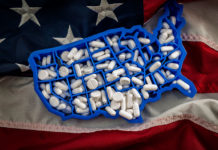Purdue Pharma is in hot water with the state of Massachusetts.
Massachusetts just sued the drug company that manufactures OxyContin. OxyContin is a powerful opioid painkiller. It, and the company that makes it, Purdue, have come under fire recently.
Critics of the drug have claimed that Purdue, and the OxyContin they manufactured and sold, are to blame for the opioid crisis that is sweeping the nation.
In a purely political action designed only to draw publicity, Massachusetts sued Purdue Pharma and its executives on Tuesday. Massachusetts government lawyers accused the company of spinning a “web of illegal deceit” to fuel the problem of drug abuse in order to boost profits.
Purdue Pharma is already being sued by several other states and local governments. Massachusetts Attorney General Maura Healey said that Massachusetts is the first state to personally name the company’s executives in a lawsuit, however. And sure enough, the Massachusetts suit does name 16 current and former executives and board members, including CEO Craig Landau and members of the Sackler family, which owns Purdue.
The lawsuit claims that Purdue tricked patients and misled doctors about the risks of opioids. The suit also makes allegation that Purdue pushed doctors to keep patients on the drugs longer than was safe, and argues that Purdue targeted vulnerable populations, like the elderly and veterans, in marketing campaigns.
“Their strategy was simple: The more drugs they sold, the more money they made, and the more people died,” Healey said.
That is, of course, a tragic oversimplification, made purely to score political points. Massachusetts, and Attorney General Healey, are tapping into an unoriginal and unsurprising “evil-big-business” narrative, which, while entertaining and attention-grabbing, is not based in reality.
The story goes like this. An evil corporation (Purdue in this case) pushes a dangerously unsafe and addictive drug into the hands of doctors, promising them that it was safe. Then, greedy doctors took the big-pharma kickbacks and prescribed loads of these dangerous drugs to people who didn’t need them. This turned innocent hospital patients into heroin addicts, who now walk the streets overdosing on fentanyl.
Of course, that’s not quite how it went. Was Purdue pushing the narrative that pain was being under-treated in America in order to sell more pain pills? Yes. But in the mid-90s, when OxyContin first hit the market, there was a genuine problem with pain-management strategies in America. Many doctors were reticent to prescribe strong medicines for fear that patients would become addicted. Many patients complained that this led to unnecessary pain and suffering.
OxyContin was designed to fix this issue. It was a slow-release drug, and Purdue claimed that made it both more effective and less likely to be abused by users.
Did Purdue market OxyContin heavily? Yes. Did it lean hard on the claim that OxyContin was “less likely to be abused”? Yes. But blaming the opioid crisis solely on Purdue is like blaming a case of tainted milk solely on the cows. In both cases, it’s really the FDA’s fault for not catching the issue.
The drug package insert inside the original OxyContin bottles made a clear claim that delayed absorption, the mechanism which made OxyContin different from other opioids “is believed to reduce the abuse liability of a drug”.
The FDA scrutinizes every scrap of a drug’s label and it’s package inserts. They approve every piece of language in or on a drug, especially one containing an active ingredient like oxycodone, which is what OxyContin contains.
The FDA allowed the claim, that OxyContin could be less prone to abuse, to stand. And, it makes sense. After all, a drug that takes effect over a long time, like OxyContin, logically would seem less abuseable than a drug like Percocet, which takes effect immediately. Less of a rush means less instant gratification, means less reason for pushers to sell it and junkies to pop it.
But the keyword there is “abuseable”, not “addictive.” OxyContin was still chemically addictive, being an opioid. Doctors knew this, and prescribed it anyway because patients in America had for years been complaining that doctors were too stingy with drugs. When OxyContin came along, it seemed like a magic pill that lasted longer and was, apparently, less dangerous than its competitors.
So doctors started giving it out like candy, often at the bidding of pharmaceutical reps. And while much has been made of the number of overdoses caused by OxyContin, what’s not mentioned in the usual stories are the actual facts.
The research that has been done on this topic shows that people who developed new addictions in recent years were, in the vast majority of cases, not actually pain patients.
Instead, they were usually friends, children, or people to whom the pills were illegally diverted. Usually young adults.
In other words, the real problem with OxyContin was its ubiquity. It worked great for a lot of people. But a lot of delinquent youth looking to make a few bucks were able to raid their grandparents medicine cabinets for Oxy. And those pills went into the hands of people who, more often than not, had pre-existing drug problems.
An early study of people being treated for OxyContin addiction found that 77 percent of those being treated for Oxy misuse had also taken cocaine. That’s an indication that misuse of prescription drugs is not an issue that happens in a vacuum. Studies also show that only 3.6 percent of the people who misuse prescription opioids actually go on to try heroin.
Although the overdose fatality numbers are high, at around 33,000 prescription drug overdose deaths in 2015 alone, the addictive potential of drugs like OxyContin has been overblown by the media. Figures are thrown about that suggest that nearly a quarter of patients who use prescription drugs will become addicted.
But these figures are nonsensical, and represent an absolute worst-case scenario that will never come to pass. If 25% of prescription opioid users really become addicted, we would expect to see millions and millions of people addicted to opioids in this country, given that just about 70% of the population will be prescribed some kind of medical opioid during their lifetime.
Instead we have about 2.5 million people in this country struggling with opioid addiction, about 1% of the population. Is that a tragic number? Absolutely.
But is it all down to OxyContin? No. Thousands of doctors prescribe opiate drugs of every sort every day in this country. And they prescribe them, in the vast majority of cases, for legitimate reasons. Getting a hip replacement hurts, after all.
The reason these drugs are still prescribed in cases of real pain is because, when properly managed and administered in the short-term, opioid drugs do help ease pain and they don’t usually cause addiction. (Even if you take the 25% addiction figure as gospel, most knee-replacement patients would probably still tell you they’d rather take those odds than spend three or four months curled up in excruciating pain. After all, there’s still a 3-out-of-four chance that they won’t get addicted.)
It’s when opioids are taken over a much longer term, or in situations where doctors aren’t monitoring patients as closely, or when disreputable pharmacists run “pill mills” to make a quick profit, that the problems really arise. And even in most of those cases, the “innocent victims” are in the minority. In the last twenty years, most of the people who got addicted to drugs like OxyContin because of medical over-prescription were still taking medicine that was prescribed to someone else or otherwise illegally obtained.
In other words, don’t believe the smug liberal elites, like Maura Healey, when they tell you it’s all the big company’s fault. Addiction is a complex issue, with many points of failure causing the problems that we’re now seeing in America.






























